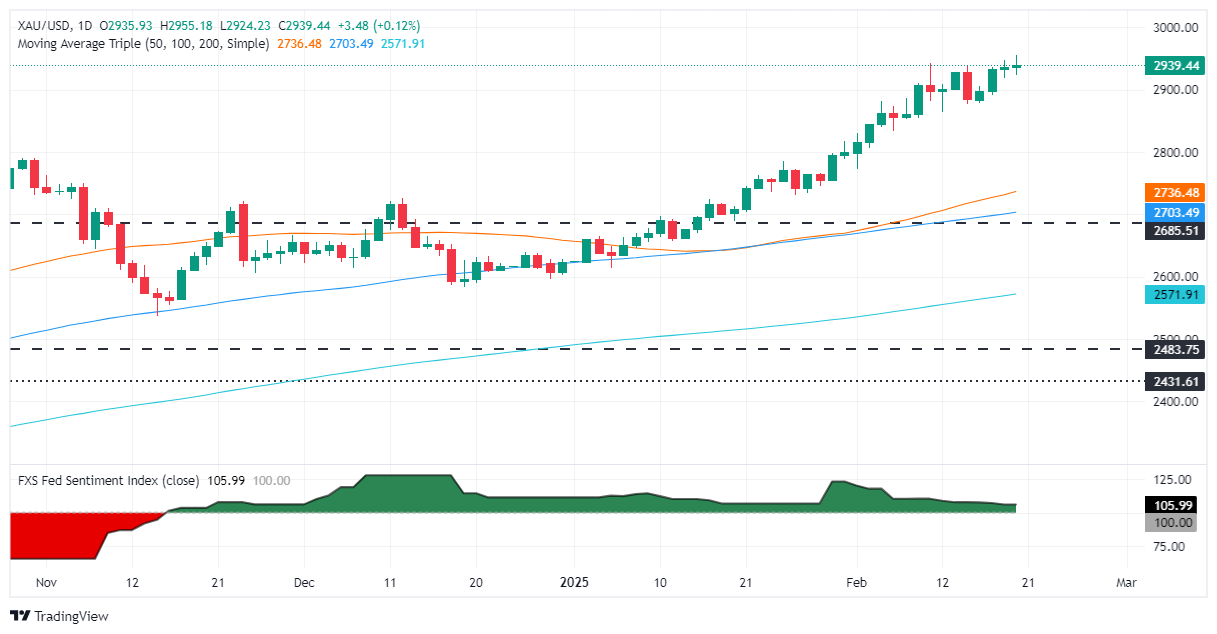- Gold rises 0.23% as risk aversion fuels safe-haven flows.
- Fed Minutes highlight inflation concerns amid Trump’s trade policies.
- Traders eye S&P Global Flash PMIs for further market direction.
Gold’s price advanced late in the North American session yet traded off record highs of $2,954 as traders took profits. Trade war woes, a weak US Dollar, and falling US Treasury bond yields kept XAU/USD trading with modest gains of 0.23% near the $2,939 mark at the time of writing.
Bullion’s demand remains fueled by uncertainty about global trade. Risk aversion sparked flows toward the safe-haven appeal of Gold alongside the Japanese Yen (JPY), which posted substantial gains during the day.
The Federal Reserve’s (Fed) Meeting Minutes from Wednesday revealed that Trump’s trade and immigration policies fueled concerns over rising prices. Hence, the Fed Chair Jerome Powell and Co. decided to hold rates unchanged at the January meeting as they assess the current economic data.
In the meantime, some Fed speakers crossed the wires and have turned slightly cautious. Atlanta Fed President Raphael Bostic sees two rate cuts this year and emphasizes that the economy is not facing a new burst of inflation. St. Louis Fed President Alberto Musalem sees some policy shifts and increased risks of inflation stalling above the Fed’s 2% goal.
Finally, Chicago’s Fed President Austan Goolsbee said that before the recent policy and geopolitical uncertainties, overall inflation “looked pretty good” and was down substantially. However, Trump’s broad-based and higher tariffs currently in development keep the Fed nervous.
Data-wise, US job data was softer than expected as the number of Americans filling out unemployment benefits came below estimates. On Friday, Gold traders are eyeing the release of S&P Global Flash PMIs.
Daily digest market movers: Gold price boosted by Trump’s tariff threats fueling safe-haven demand
- US President Donald Trump recently announced that tariffs on cars, automobiles, and computer chips would be around 25%. He also said on Wednesday that duties would broaden to other commodities like lumber.
- US Initial Jobless Claims for the week ending February 15 increased by 219K, exceeding forecasts of 215K.
- The US 10-year Treasury bond yield falls three basis points (bps) and yields 4.505%.
- US real yields, which correlate inversely to Bullion prices, drop three basis points to 2.04%, a tailwind for Bullion prices.
- The World Gold Council revealed that central bank purchases rose more than 54% YoY to 333 tonnes following Trump’s victory, according to its data.
- Money market fed funds futures are pricing in 41.5 basis points of easing by the Fed in 2025.
XAU/USD technical outlook: Gold price faces stir resistance and retreats
Gold price uptrend remains intact, even though it has failed to decisively clear the $2,950 figure, opening the door for a pullback. Momentum shows overstretched as the Relative Strength Index (RSI) exited from overbought conditions, suggesting that sellers are gathering momentum.
In that outcome, the first support would be the February 14 swing low of $2,877, followed by the February 12 daily low of $2,864.
On the other hand, if XAU/USD rises past $2,954, the first resistance would be the psychological $2,950, followed by $3,000.
Tariffs FAQs
Tariffs are customs duties levied on certain merchandise imports or a category of products. Tariffs are designed to help local producers and manufacturers be more competitive in the market by providing a price advantage over similar goods that can be imported. Tariffs are widely used as tools of protectionism, along with trade barriers and import quotas.
Although tariffs and taxes both generate government revenue to fund public goods and services, they have several distinctions. Tariffs are prepaid at the port of entry, while taxes are paid at the time of purchase. Taxes are imposed on individual taxpayers and businesses, while tariffs are paid by importers.
There are two schools of thought among economists regarding the usage of tariffs. While some argue that tariffs are necessary to protect domestic industries and address trade imbalances, others see them as a harmful tool that could potentially drive prices higher over the long term and lead to a damaging trade war by encouraging tit-for-tat tariffs.
During the run-up to the presidential election in November 2024, Donald Trump made it clear that he intends to use tariffs to support the US economy and American producers. In 2024, Mexico, China and Canada accounted for 42% of total US imports. In this period, Mexico stood out as the top exporter with $466.6 billion, according to the US Census Bureau. Hence, Trump wants to focus on these three nations when imposing tariffs. He also plans to use the revenue generated through tariffs to lower personal income taxes.






